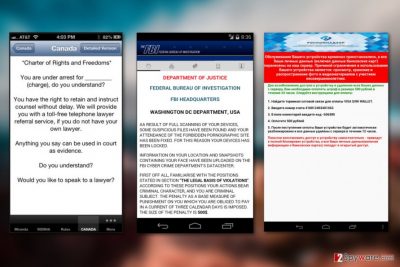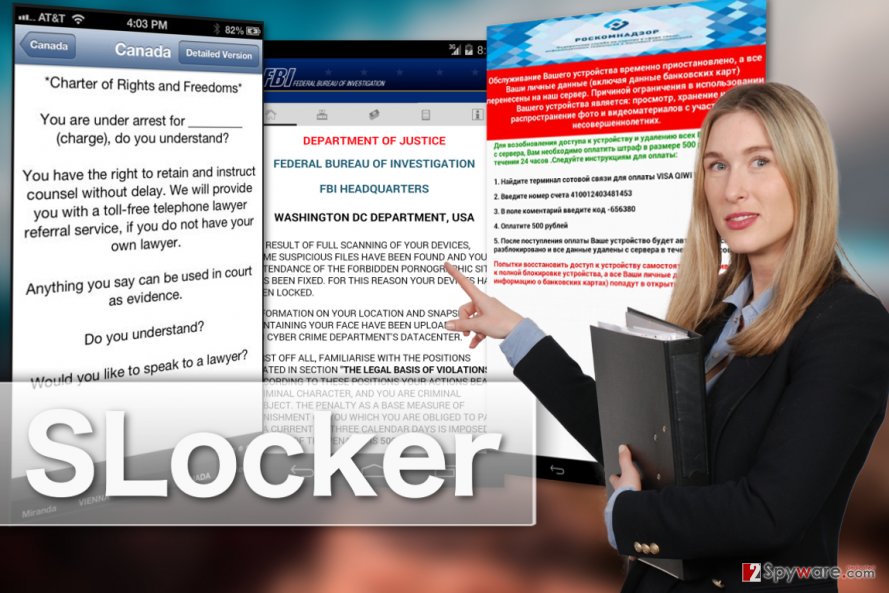SLocker ransomware / virus (Removal Guide) - Virus Removal Guide
SLocker virus Removal Guide
What is SLocker ransomware virus?
Infamous SLocker makes a huge comeback with 400 new malware versions
SLocker is probably the most notorious Android virus which was also the first one to start using encryption to render victims’ files unintelligible. The virus was first brought to light in 2016 after its active campaign began causing havoc on users’ devices. However, after the wave of initial attacks has passed by, the virus seemed to have gradually died down. Antivirus software vendors contributed hugely to the immobilization of this threat [1]. Besides, the virus itself was not especially well built itself. The victims could simply remove SLocker by performing factory reset even though this meant the loss of the encrypted files. Unfortunately, the malware’s disappearance was merely a calm before the storm, and at the beginning of May 2017, the virus has hit the web with 400 new malicious versions [2]. As expected, hackers were not wasting their time but seriously working on improving these new variants in order to make them more resistant and more effective. It is has become especially difficult to find samples of these parasites since they now tend to use a wide range of different disguises. The virus may even infiltrate legitimate software sharing platforms and spread there as legitimate third-party applications. In such cases, the virus completes all of its predetermined processes before the victims realize they should perform the SLocker removal. Unfortunately, the virus will not leave your device that easily. Therefore, it is much easier to take preventative actions before the virus hits your device. We recommend downloading FortectIntego Cleaner from the Google Play store or install https://www.2-spyware.com/download-bullguard-mobile-security.exe”>BullGuard Mobile Security to supply your device with extra protection.

SLocker is the virus that set up a new trend of smartphone ransomware which is now growing rapidly not only in Android but across other operating systems as well. Nowadays, people have half their life stored on their tablets and smartphones, including pictures, videos, documents and other data. So, ransomware attack on these devices can have just as harsh of an impact as the encryption of PCs. Naturally, there will always be people who will consider paying the extortionist for the data recovery. However, we strongly advise not to do that. Don’t support the cybercriminals and simply get rid of the virus instead.

Methods Android ransomware may use to infiltrate your device
There are a lot of zero-day vulnerabilities on smartphones and tablets that SLocker may use for the device infiltration. As we’ve mentioned, the virus can be downloaded as regular-looking application which will use modified icons, deceptive package names and obfuscated executables to operate on the devices undetected. Also, the virus may hit the device while visiting corrupted websites which contain infectious ads. These ads will automatically download the malicious payload on the device. Our advice here is simple: stay away from suspicious third-party software, avoid visiting shady websites, and you will not have to waste your time dealing with SLocker.
Preparing for SLocker removal
The essential step of SLocker removal preparation is the acquisition of a powerful malware elimination tool. These tools may help decontaminate the virus, though their effectiveness is not 100% guaranteed. Booting your device in Safe Mode may be helpful. If the data on your device is not especially important to you, you may as well remove SLocker virus by performing factory reset. You will find some useful tips on how to deal with an Android virus in our expert-prepared article here.
Getting rid of SLocker virus. Follow these steps
Manual removal using Safe Mode
To enable Safe Mode on your Android device:
- Turn of your phone and then turn it back on again
- Once the device starts booting, try press-hold the Menu, Volume Down and Volume Up buttons.
- When you see an options window, navigate to Safe Mode with the Volume button
Important! →
Manual removal guide might be too complicated for regular computer users. It requires advanced IT knowledge to be performed correctly (if vital system files are removed or damaged, it might result in full Windows compromise), and it also might take hours to complete. Therefore, we highly advise using the automatic method provided above instead.
Step 1. Access Safe Mode with Networking
Manual malware removal should be best performed in the Safe Mode environment.
Windows 7 / Vista / XP
- Click Start > Shutdown > Restart > OK.
- When your computer becomes active, start pressing F8 button (if that does not work, try F2, F12, Del, etc. – it all depends on your motherboard model) multiple times until you see the Advanced Boot Options window.
- Select Safe Mode with Networking from the list.

Windows 10 / Windows 8
- Right-click on Start button and select Settings.

- Scroll down to pick Update & Security.

- On the left side of the window, pick Recovery.
- Now scroll down to find Advanced Startup section.
- Click Restart now.

- Select Troubleshoot.

- Go to Advanced options.

- Select Startup Settings.

- Press Restart.
- Now press 5 or click 5) Enable Safe Mode with Networking.

Step 2. Shut down suspicious processes
Windows Task Manager is a useful tool that shows all the processes running in the background. If malware is running a process, you need to shut it down:
- Press Ctrl + Shift + Esc on your keyboard to open Windows Task Manager.
- Click on More details.

- Scroll down to Background processes section, and look for anything suspicious.
- Right-click and select Open file location.

- Go back to the process, right-click and pick End Task.

- Delete the contents of the malicious folder.
Step 3. Check program Startup
- Press Ctrl + Shift + Esc on your keyboard to open Windows Task Manager.
- Go to Startup tab.
- Right-click on the suspicious program and pick Disable.

Step 4. Delete virus files
Malware-related files can be found in various places within your computer. Here are instructions that could help you find them:
- Type in Disk Cleanup in Windows search and press Enter.

- Select the drive you want to clean (C: is your main drive by default and is likely to be the one that has malicious files in).
- Scroll through the Files to delete list and select the following:
Temporary Internet Files
Downloads
Recycle Bin
Temporary files - Pick Clean up system files.

- You can also look for other malicious files hidden in the following folders (type these entries in Windows Search and press Enter):
%AppData%
%LocalAppData%
%ProgramData%
%WinDir%
After you are finished, reboot the PC in normal mode.
Remove SLocker using System Restore
-
Step 1: Reboot your computer to Safe Mode with Command Prompt
Windows 7 / Vista / XP- Click Start → Shutdown → Restart → OK.
- When your computer becomes active, start pressing F8 multiple times until you see the Advanced Boot Options window.
-
Select Command Prompt from the list

Windows 10 / Windows 8- Press the Power button at the Windows login screen. Now press and hold Shift, which is on your keyboard, and click Restart..
- Now select Troubleshoot → Advanced options → Startup Settings and finally press Restart.
-
Once your computer becomes active, select Enable Safe Mode with Command Prompt in Startup Settings window.

-
Step 2: Restore your system files and settings
-
Once the Command Prompt window shows up, enter cd restore and click Enter.

-
Now type rstrui.exe and press Enter again..

-
When a new window shows up, click Next and select your restore point that is prior the infiltration of SLocker. After doing that, click Next.


-
Now click Yes to start system restore.

-
Once the Command Prompt window shows up, enter cd restore and click Enter.
Bonus: Recover your data
Guide which is presented above is supposed to help you remove SLocker from your computer. To recover your encrypted files, we recommend using a detailed guide prepared by 2-spyware.com security experts.If your files are encrypted by SLocker, you can use several methods to restore them:
Finally, you should always think about the protection of crypto-ransomwares. In order to protect your computer from SLocker and other ransomwares, use a reputable anti-spyware, such as FortectIntego, SpyHunter 5Combo Cleaner or Malwarebytes
How to prevent from getting ransomware
Choose a proper web browser and improve your safety with a VPN tool
Online spying has got momentum in recent years and people are getting more and more interested in how to protect their privacy online. One of the basic means to add a layer of security – choose the most private and secure web browser. Although web browsers can't grant full privacy protection and security, some of them are much better at sandboxing, HTTPS upgrading, active content blocking, tracking blocking, phishing protection, and similar privacy-oriented features. However, if you want true anonymity, we suggest you employ a powerful Private Internet Access VPN – it can encrypt all the traffic that comes and goes out of your computer, preventing tracking completely.
Lost your files? Use data recovery software
While some files located on any computer are replaceable or useless, others can be extremely valuable. Family photos, work documents, school projects – these are types of files that we don't want to lose. Unfortunately, there are many ways how unexpected data loss can occur: power cuts, Blue Screen of Death errors, hardware failures, crypto-malware attack, or even accidental deletion.
To ensure that all the files remain intact, you should prepare regular data backups. You can choose cloud-based or physical copies you could restore from later in case of a disaster. If your backups were lost as well or you never bothered to prepare any, Data Recovery Pro can be your only hope to retrieve your invaluable files.
- ^ Tara Seals. SLocker Android ransomware resurfaces in undetectable form. Infosecurity-magazine. Information Security & IT Security News and Resources.
- ^ Gabriel E. Hall. SLocker ransomware comes back and puts Android users at even bigger risk. 2-spyware. It news and malware removal resources.





















